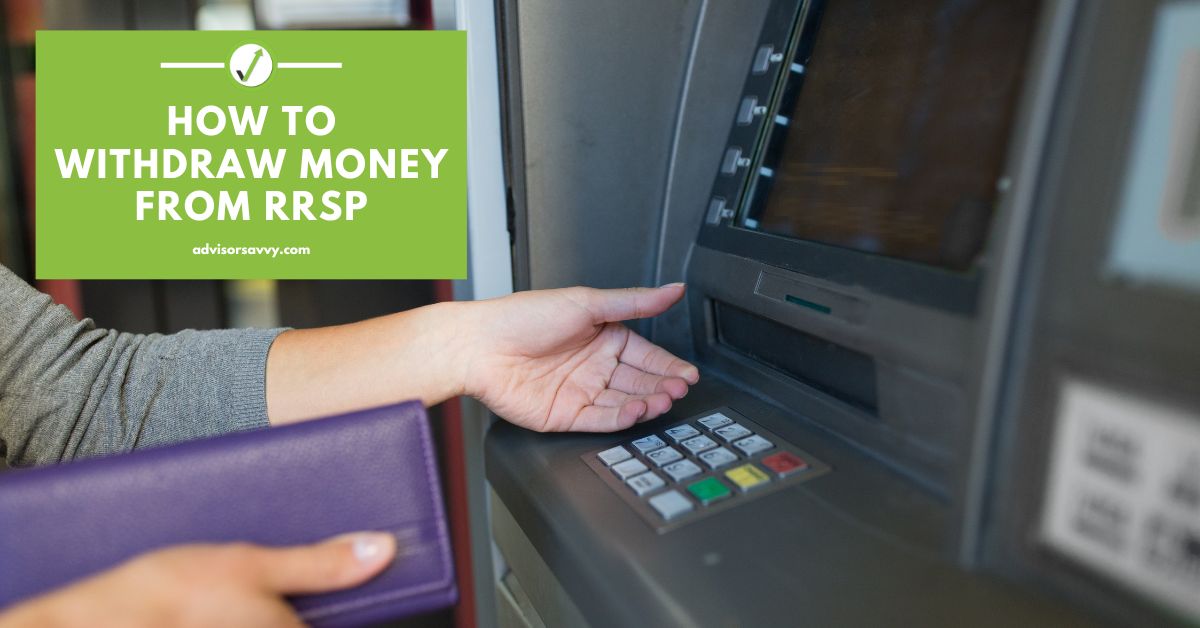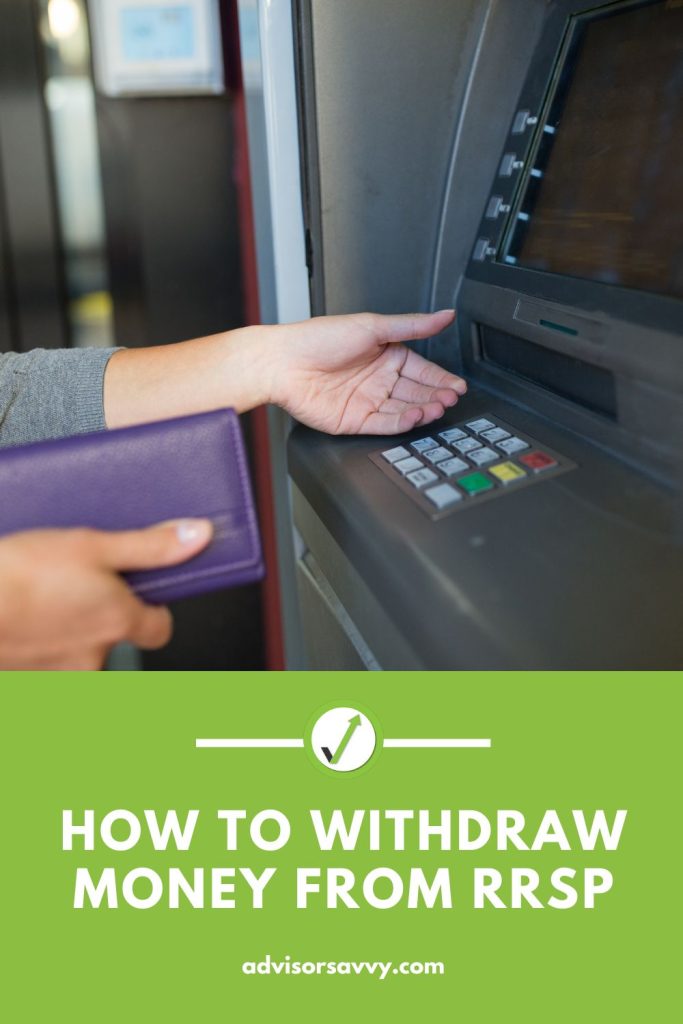
If you’re here, you’ve probably come across an unexpected expense or there’s something you want to invest in, such as a home or education. You may be considering a withdrawal from your RRSP to cover the cost at hand. It’s a good thing you decided to read up on RRSP withdrawals before actioning one because there are several things to consider! In this article, we’ll explore everything you need to know before making a withdrawal and how to withdraw money from RRSP accounts, if you really need to.

Table of contents
What is a RRSP?
RRSP stands for Registered Retirement Savings Plan. The account was originally introduced in 1957 as a part of the Canadian Income Tax Act. It is a special account used to save for retirement and is equipped with various tax advantages. The main tax benefit is investment income, such as capital gains and dividends, is sheltered from tax. There are restrictions on the account to encourage plan holders to keep funds in their account until they reach retirement age. Let’s take a closer look below.
Related Reading: The RRSP In Canada: A Complete Strategy Guide
Special rules: contributions and withdrawals
Because RRSPs are registered accounts, they are subject to special rules surrounding contributions and withdrawals. It’s important to be mindful of these because non-registered accounts don’t have the same kind of restrictions. Below is a summary of the RRSP contribution and withdrawal rules.
| Contributions | Withdrawals |
| There is a RRSP deduction limit which is based on your earned income from previous years. | You can withdraw from your RRSP before the age of retirement, but a 10% to 30% withholding tax applies. |
| Contributions to your RRSP can be deducted on your tax return. Your taxable income will be lower as a result. | Money withdrawn from your RRSP must be reported as income on your tax return, even in retirement. |
| If you contribute more than your allowed limit, you will face a 1% monthly tax on the excess amount. | Withdrawals for home purchases and education are allowed under the Home Buyers’ Plan (HBP) and the Lifelong Learning Plan (LLP). These withdrawals are more like a loan from your RRSP because they can be repaid. |
| Amounts in your RRSP can be invested into a bunch of assets, including stocks, bonds, GICs and more. Investment income earned is not taxed in a RRSP. | Once a withdrawal happens, you cannot reuse the RRSP contribution room, except under the HBP and LLP programs. |
Tax consequences of withdrawing from RRSP
Withdrawing from a RRSP is absolutely possible. However, there are various consequences related to tax and other aspects of your personal finances. Before completing a withdrawal, it’s important to consider these implications. Below is a summary of the implications.
Withholding tax
Withdrawals from your RRSP must be included as income on your tax return. Because there’s an additional tax arising from RRSP withdrawals, a withholding tax applies to cover a portion of the tax bill. In addition, a withholding tax motivates Canadians to keep funds in their RRSP. Unfortunately, there is no way around the withholding tax, except if you use the Home Buyers’ Plan or the Lifelong Learning Plan.
The silver lining is the withholding tax rate is based on how much you withdraw. If you really need to make a withdrawal, there is an opportunity to optimize. Below are the withholding tax rates on RRSP withdrawals:
| Withdrawal Amount | Tax rate (Quebec) | Tax rate (all of Canada, except Quebec) |
| $1 to $5,000 | 5% | 10% |
| $5,001 to $15,000 | 10% | 20% |
| $15,001 or more | 15% | 30% |
RRSP contribution room gone forever
When you make a premature withdrawal from your RRSP, the contribution room goes away forever. You do not have the opportunity to re-contribute an amount you previously withdrew. In the long run, this will affect your retirement nest egg because you have a smaller fund available to you to optimize tax benefits in the account.
Related Reading: What is My RRSP Contribution Limit?
The only exception is under the Home Buyers’ Plan and Lifelong Learning Plan. Both of these programs allow you to repay withdrawn amounts over a specified period.
Lost opportunity on investments
Sometimes, individuals must sell investments in their RRSP to facilitate a cash withdrawal. By selling your investments early, you’re losing on the long-term capital gains and other investment income. This is more commonly referred to as an opportunity cost. In other words, an opportunity cost is the loss of a benefit when pursuing another alternative. With an RRSP withdrawal, the opportunity cost is losing gains on investments for the alternative of having the cash now.
How to withdraw money from RRSP tax-free
Unfortunately, you cannot evade taxes when withdrawing from an RRSP. This is true both before and after retirement. Even though this is cumbersome when you’re in need of cash, remember the account has various tax advantages and is designed to motivate you to save for retirement. It is not designed to be used as a general savings account or emergency fund.
The only exception to this rule is under the Home Buyers’ Plan and the Lifelong Learning Plan. If you want to withdraw from your RRSP for a home purchase or to pursue education, you can take out funds without tax penalty. The amount you withdraw can be repaid into your RRSP over time and there are eligibility criteria to consider. Below is more information on these special programs.
Home Buyers’ Plan: How to withdraw money from RRSP for house
The Home Buyers’ Plan (HBP) allows RRSP account holders to withdraw up to $35,000 for a home purchase for themselves or a related person with a disability. The program allows you to repay the withdrawn amount over a period of 15 years. There is a lot of flexibility with repayment and this regulation is in place to ensure you don’t lose the contribution room. No withholding tax applies in this situation, but your RRSP deduction may be impacted by an HBP withdrawal.
Below is the eligibility criteria for the HBP:
- Be a first time home buyer
- Have a written agreement to build or buy a property
- Be a resident of Canada
- Intend to occupy the home within a 1 year period after purchasing the property
If you’re eligible, begin filling out the necessary paperwork to make a withdrawal. It starts with Form T1036, Home Buyers’ Plan (HBP) Request to Withdraw Funds from an RRSP.
Lifelong Learning Plan: How to withdraw money from RRSP for education
The Lifelong Learning Plan (LLP) allows you to withdraw up to $10,000 per calendar year from your RRSP to finance education costs for you, your spouse or common-law partner. There are no limitations on how many times you can apply to LLP in your lifetime. This is helpful to know since most education programs last several years. In addition, you may want to pursue more education later in life. Once you make a withdrawal, you must repay the amount to your RRSP over a 10 year period. The only requirement to apply again is to repay previously withdrawn amounts. However, for a multiple year program, your repayment period would not begin until your education is complete.
To make a RRSP withdrawal under the LLP program, you must meet the following criteria:
- The individual applying must be enrolled in full-time education, or have an offer to enroll
- Be a resident of Canada
RRSP deductions on your tax return can be affected by LLP withdrawals. If you’re ready to apply for the LLP program, you can start the process by completing Form RC96, Lifelong Learning Plan (LLP) – Request to Withdraw Funds From an RRSP.
Unfortunately, you cannot use the LLP program to finance education costs for your children, or your spouse/common-law partner’s children. Instead, consider a Registered Education Savings Plan (RESP).
How to withdraw money from RRSP
At this point, you’re aware of the risks and consequences of withdrawing money from your RRSP outside of the HBP and LLP. If you’re ready to make a RRSP withdrawal, here are the steps to follow:
- Determine withdrawal amount. Calculate the amount you need to withdraw to ensure your proceeds are enough to cover the expense in question net of withholding tax.
- Contact your bank and withdraw. Next, you can complete the RRSP withdrawal online, by visiting a branch or by calling your bank. Depending on how much you need, you may need to liquidate some investments to access the cash. Remember it can take a few days for these transactions to settle.
- Report the withdrawal on your tax return. When tax season comes around, you’ll need to report the withdrawn amount as income on your tax return. This may cause your tax bill to be higher than usual.
Related Reading: RRSP Withdrawal Rules: What to Know
Think before you withdraw
In general, RRSP withdrawals are not recommended because of the numerous consequences and tax implications. Be sure to understand all the moving parts before initiating a withdrawal. It’s also wise to consider other options before a RRSP withdrawal. For instance, you can withdraw from other savings or a Tax-Free Savings Account (TFSA). Alternatively, you can take out financing or ask friends and family for a loan. If none of these avenues are an option, then a RRSP withdrawal can be considered.
Related Reading: How to Withdraw Money from TFSA
